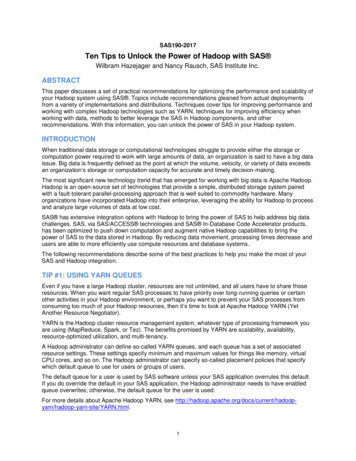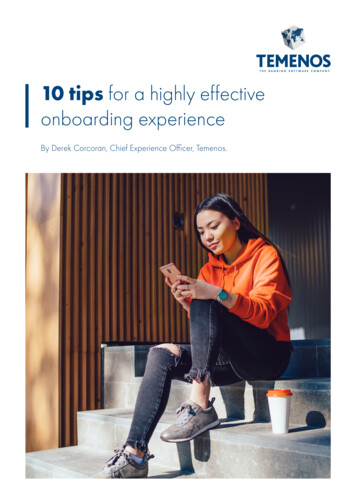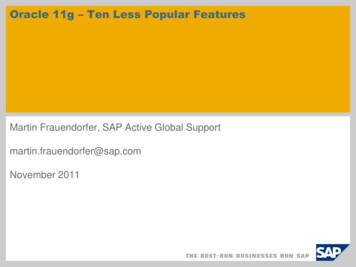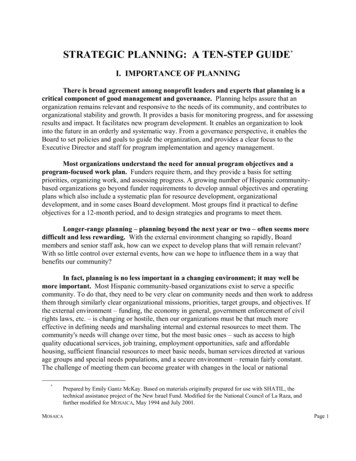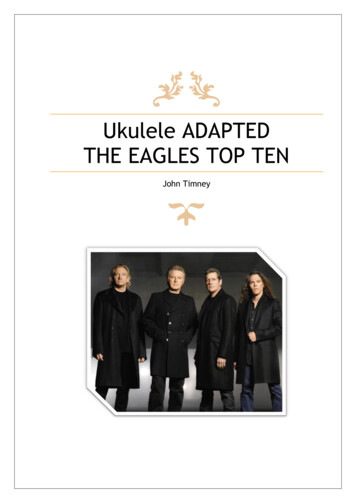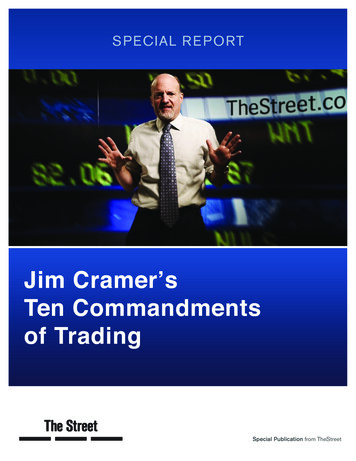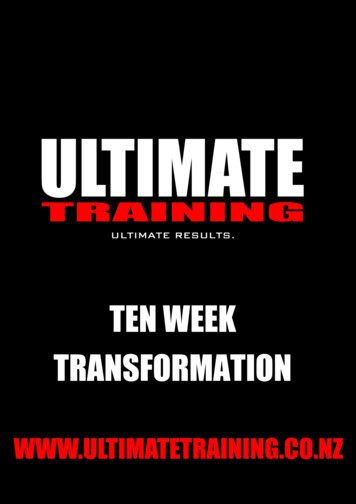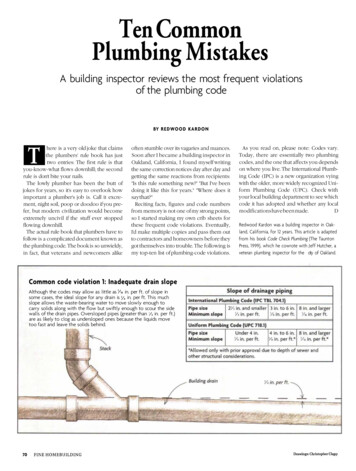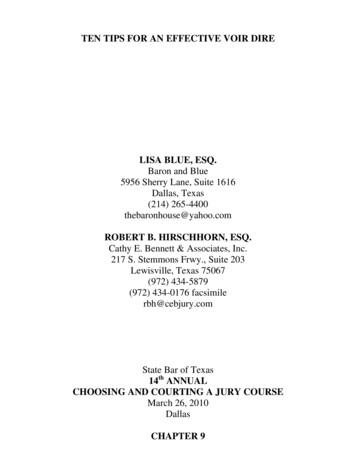
Transcription
TEN TIPS FOR AN EFFECTIVE VOIR DIRELISA BLUE, ESQ.Baron and Blue5956 Sherry Lane, Suite 1616Dallas, Texas(214) 265-4400thebaronhouse@yahoo.comROBERT B. HIRSCHHORN, ESQ.Cathy E. Bennett & Associates, Inc.217 S. Stemmons Frwy., Suite 203Lewisville, Texas 75067(972) 434-5879(972) 434-0176 facsimilerbh@cebjury.comState Bar of Texas14th ANNUALCHOOSING AND COURTING A JURY COURSEMarch 26, 2010DallasCHAPTER 9
Ten Tips for an Effective Voir DireChapter 9TABLE OF CONTENTSPage #I.Lisa Blue’s and Robert Hirschhorn’s Biographical Information . . . . 2II.76 Jury Selection Tips . . . . . . . . . . . . . . . . . . . . . . . . . . . . . . . . . . 3III.How to Conduct a Meaningful and Effective30-Minute Voir Dire . . . . . . . . . . . . . . . . . . . . . . . . . . . . . . . . . . . . . . . . . 12IV.Goals and Practical Tips for Voir Dire . . . . . . . . . . . . . . . . . . . . . . . . . 46V.A Guide to Analyzing Jury Questionnaires in Civil Cases . . . . . . . . . 78VI.Dos and Don’ts of Jury Questionnaires . . . . . . . . . . . . . . . . . . . . . . . . 89VII.Sample Challenge for Cause Chart . . . . . . . . . . . . . . . . . . . . . . . . . . . . 92VIII.Sample One-Page Juror Questionnaires . . . . . . . . . . . . . . . . . . . . . . . 931.Personal Injury . . . . . . . . . . . . . . . . . . . . . . . . . . . . . . . . . . . . . . . 932.Product Liability . . . . . . . . . . . . . . . . . . . . . . . . . . . . . . . . . . . . . . 94IX.Sample Multiple Page Juror Questionnaires1.Employment . . . . . . . . . . . . . . . . . . . . .2.Breach of Contract . . . . . . . . . . . . . . . .3.Wrongful Death . . . . . . . . . . . . . . . . . . .4.Personal Injury . . . . . . . . . . . . . . . . . . .X.Sample Employment Voir Dire Questions . . . . . . . . . . . . . . . . . . . . . 111XI.Blue’s Guide to Jury Selection Information . . . . . . . . . . . . . . . . . . . . 118i. 95. 95. 99102106
ROBERT B. HIRSCHHORN217 STEMMONS FREEW AY, SUITE 203LEW ISVILLE, TEXAS 75067OFFICE: (972) 434-5879E - MAIL :rbh@cebjury.comFAX: (972) 434-0176BIOGRAPHICAL INFORMATIONEDUCATION:St. Mary's University School of Law, J.D. - 1981Clark University, B.A. (Government and International Relations) Cum Laude - 1978EMPLOYMENT:Associate with Goldstein, Goldstein & Hilley, San Antonio, Texas 1981 - 1984Cathy E. Bennett & Associates, Inc., Jury and Trial Consultants - 1984 to PresentPARTIAL LISTING OF CASES:[Clients are in BOLD print]ERNST V . MERCK - Vioxx wrongful death; 253M VERDICT FOR PLAINTIFFS ;STRONG v. DUPONT - TOXIC TORT 15.5M VERDICT FOR THE PLAINTIFFS ;LEXAR V .TOSHIBA - Breach of Fiduciary Duty; 461M FOR PLAINTIFF .HALE , ET AL . V . SEECO - Underpayment to royalty owners; 92M VERDICT FOR PLAINTIFFS ;BONICELLI V . ESTATE OF BONICELLI - Wrongful death; 32.5M VERDICT FOR PLAINTIFFS :BUCKINGHAM GATE V . LEXINGTON INS . CO ., ET AL . - Breach of contract; 16M VERDICT FOR PLAINTIFF ;SERAW V METZGER - Wrongful death and racial intimidation; 12.5M VERDICT FOR PLAINTIFF ;RAPER V . PC - Single plaintiff asbestos case; 9.2M VERDICT FOR PLAINTIFF ;KASZAR , ET AL . V . ACUTE CARE SPECIALISTS , INC . - Medical Malpractice; 8.4M VERDICT FOR PLAINTIFFS ;JACOBSEN V . GTE - Breach of Contract; 7.2M VERDICT FOR PLAINTIFF ;APPLIED MATERIALS V . NOVELLUS - Patent infringement; VERDICT FOR PLAINTIFF ;INTEL V . AMD - Patent infringement case; VERDICT FOR PLAINTIFF ;KEARNS V . FORD - Intermittent windshield wiper patent case; VERDICT FOR PLAINTIFF ;TAYLOR V . ZURICH INSURANCE CO . - Insurance bad faith case; VERDICT FOR PLAINTIFF ;CONTINENTAL & NORTHW EST AIRLINES V . AMERICAN AIRLINES - Antitrust; VERDICT FOR DEFENDANT ;MECHE V . WAL MART - Class action litigation; VERDICT FOR DEFENDANT ;FUALAUU , ET AL . V . CITY OF DES MOINES , ET AL . - Mary Kay Letourneau civil case; VERDICT FOR DEFENDANTS ;ROJAS , ET AL . V . THE KROGER COMPANY - Wrongful death; VERDICT FOR DEFENDANT ;SALDANA V . COSTCO - Car seat strangulation death; VERDICT FOR DEFENDANT ;ZIXIT V . VISA - Defamation; VERDICT FOR DEFENDANT ;STATE OF FLORIDA V . WILLIAM KENNEDY SMITH - Sexual battery; ACQUITTED ;STATE OF TEXAS V . SENATOR KAY BAILEY HUTCHISON ; Ethics case; JUDGE ORDERED JURY TO ACQUIT ;STATE OF TEXAS . V . ROBERT DURST - Murder/Dismemberment; NOT GUILTY ;U.S.A. V . TERRY LYNN NICHOLS - Oklahoma City Bombing trial; ACQUITTED OF ALL M URDER CHARGES ;LEGAL PUBLICATIONS:“Effective Techniques for Jury Selection” (1985)“Jury Selection: A Trial Lawyer's Second Greatest Fear” (1986)“Expanding Voir Dire in Federal Court” (1987)“Opening Statements”, 42 Mercer University Law Review 605 (1991)“How to Conduct a Meaningful Voir Dire in Criminal Cases”, 46 SMU Law Review 659 (1992)Bennett's Guide to Jury Selection and Trial Dynamics in Civil and Criminal Litigation, West PublishingCompany (1993)Bennett's Guide to Jury Selection and Trial Dynamics in Civil and Criminal Litigation; California Edition,West Publishing Company (1995)“How to Conduct a Meaningful and Effective 30-Minute Voir Dire”, The Advocate (1996)Blue’s Guide to Jury Selection, Thomson West Publishing (2005)MEDIA:Robert Hirschhorn has been quoted numerous times in USA Today, L.A. Times and the New York Times.He has appeared on: Good Morning America, MSNBC, Court TV, CNN, Dateline NBC, 48-Hours, Nightline,McNeil Lehrer, Rivera Live, the Oprah Winfrey Show, and many national radio programs. He lecturesthroughout the United States to lawyers and judges on the art of jury selection.
Ten Tips for an Effective Voir DireChapter 976 JURY SELECTION TIPSPREPARING FOR JURY SELECTION1.Voir dire begins the day the client walks through your door.2.Keep a voir dire notebook. Issues will arise throughout the discovery processthat will help you prepare for jury selection.3.Every case, like every good book, has a trial theme. The purpose of the trialtheme is to grab the jury’s attention like a newspaper uses headlines to grabthe readers’ attention.4.Use visual aides in voir dire. Examples would be: Explaining the burden ofproof, showing who the parties are, showing a blow-up of the location of theaccident, showing examples of some of the questions the jury will beanswering during their deliberations, etc.5.Trilogies are a Powerful, Permanent and Profound communication tool.6.Determine from the Judge the size of the panel in advance of jury selection.7.Determine from the Judge or other Court staff how the jurors will be seatedin the courtroom and prepare a seating chart.8.Once you know how many jurors the Judge intends to call, make 8½” x 11"cards that contain the juror numbers. The jurors can hold the cards up whenanswering questions during voir dire. Have the cards laminated. Considerleaving the cards with the Court once the case is over.9.Liability juries and damages juries do not look the same. Decide whetheryou’re looking for a liability jury or a damages jury. In our view, it is a fatalmistake to try to combine the two because you’ll get the worst of both worlds.10.No matter how many cases you have tried, there are no two trials that areexactly alike. Therefore, regardless of your experience in front of a jury,practice your voir dire.on lay-people, not your office staff or law partners.11.Have someone assist you with jury selection. This person will become youreyes and ears.-3-
Ten Tips for an Effective Voir DireChapter 912.If a juror questionnaire is used, the lawyer should complete one as well. Thisis another way to humanize yourself in front of the jury.13.Try to persuade the Judge to deal with challenges for cause at the end of voirdire as opposed to when they arise. It is always more time efficient to do thechallenges for cause at the end of voir dire.14.If the Judge will not allow the use of a juror questionnaire and intends toplace unreasonable time limits on voir dire, prepare a Motion for AdditionalTime to Conduct Voir Dire. To the author’s knowledge, there is not a singlepublished opinion on issue of time limitations in a civil case.DRESSED FOR SUCCESS15.Remember the wise advice we got from our parents: First impressions arelasting impressions; and, You never get a second chance to make a firstimpression. You and your client are the center of attention and your goal isto make a favorable and lasting first impression on the jury.16.Never wear power clothing during voir dire unless you have to give yourOpening Statement the same day. Power clothing should be worn when youwant the jury to focus their attention on you. Thus, Opening Statements,critical cross-examinations and Closing Arguments are the proper time towear power clothing. During voir dire, warm and friendly colors should beworn.17.A trial lawyer should not wear a double-breasted suit. Jurors perceive it astoo slick.18.Male lawyers should not wear clear polish on their nails. Jurors perceive itas too slick.19.Don’t wear: Expensive jewelry, diamonds, pinky rings (or more than one ringon each hand), earrings that dangle, fancy rings, Rolex watches, goldbracelets, etc.20.All of the tips stated above apply to your clients, their spouses and yourwitnesses.21.Never have your client wear new shoes. It is a dead giveaway that you’ve toldthem what to wear.-4-
Ten Tips for an Effective Voir DireChapter 922.Research has shown that jurors trust married men who wear wedding bandsmore than married men who don’t wear wedding bands.23.Tell your clients that they are being observed from the minute they leave theirhouse to the time they get back home. They need to remember to act thesame way in the elevator, bathroom and hallways as they do in the courtroom.JUROR QUESTIONNAIRE24.With a simple and straightforward case, your questionnaire should be nolonger than 1 or 2 pages. The more complex the issues and the more time youhave to review the questionnaires, the longer the questionnaires can be.25.Logically organize your questionnaire. The first section should bebiographical, the next section should be issue-specific to your case, the thirdsection should be psychological profile questions, and the final sectionshould contain questions to determine any connections jurors have to theparties, lawyers or witnesses and any hardship issues.26.At least 10% of the questions should be open-ended, 10% should be scaled,and remaining questions on the questionnaire should be the YES NOvariety.27.Every YES NO question should have a follow-up question (i.e., why,please explain your answer, please tell us why you feel this way, etc.).28.Provide the Court with black ink pens and clipboards for the jurors.29.Give the Judge a diskette that contains your juror questionnaire. If the Courthas to resolve any disagreement on the questionnaire, many Judges will makethe changes right on the disk.GENERAL VOIR DIRE PRINCIPLES30.During voir dire, a lawyer should only have with him/her a seating chart of thejurors and the questions that are going to be asked of the jury.31.Use your seating chart to address the jurors by name rather than by jurornumbers.-5-
Ten Tips for an Effective Voir DireChapter 932.Never do your voir dire from behind a podium or counsel table unlessrequired to do so by the Judge or local rule.33.Don’t flirt with jurors. The other jurors will notice it and punish you and yourclient for it.34.Studies suggest that most people tend to favor one side over the other.During voir dire, be sure to speak to jurors on both the left and right sides ofthe courtroom. This also applies to Opening Statements and ClosingArguments.35.Jurors will remember the first and last things they hear and see. This isknown as primacy and recency. Therefore, it is critically important that youstart and end your voir dire on strong points. This concept also applies toOpening Statements, examination of witnesses and Closing Arguments.BEGINNING YOUR VOIR DIRE36.Don’t talk like an attorney, talk like a person.37.Begin your voir dire with your trial theme.38.Concisely explain your theory of the case in the beginning of voir dire. Thetheory of the case tells a jury, in a nutshell, why you should win. Reinforceyour theory in Opening Statements, examination of witnesses and ClosingArguments.39.Before you begin questioning the panel, explain to the jurors that whenlawyers refer to bias or prejudice, they mean pre-judgement or strongopinions. Tell the jurors that if they have any pre-judgment or strong opinionsabout any of the issues, to please let you know.40.Let the jury know that many times jurors want to talk privately about ananswer to a question. Tell them if any juror would feel more comfortablesharing an answer in private, that person should simply let you know.41.Tell the jurors there are no right ore wrong answers. All that you are askingis that the jurors be honest and forthright. Never tell the jurors that you arelooking for 12 (or 6), “.fair and impartial jurors.” This will condition thejurors to give the fair and impartial response rather than the honest response.-6-
Ten Tips for an Effective Voir DireChapter 942.Tell your panel that, “Being a good juror and a good citizen means that if thiscase is not the right one for you to serve on, just let the lawyers and Judgeknow.”43.Tell the jurors that it’s been your experience that many jurors believe that ifthey don’t talk, they won’t be selected. Then tell the jurors that the quickestway to be selected is not to say anything. In other words, jurors who talk,walk. Jurors who have nothing to say, stay!44.At some point during the beginning of voir dire , a lawyer should employ aneffective communication technique called self-disclosure. If a lawyer wants(and expects) to learn about his/her jurors, those jurors will feel morecomfortable if the lawyer reveals something about herself/himself.THE BODY OF VOIR DIRE45.If a lawyer has a habit, trait or any other characteristic that is obvious ornoticeable (i.e. stuttering, nervousness, sweating, stumbling over words, loudvoice, soft voice, object often, bald, overweight, ponytail, etc.), share that upfront with the jury. Ask one or two jurors if this habit, etc., will affect them orcause them any discomfort if they serve on the jury in this case. This willeliminate the distraction and allow the juror to focus on the issues.46.Never be condescending or dismissive to a juror.47.Your voir dire questions should be short, simple and to the point.48.Don’t ask the same question in voir dire that you ask on the questionnaire.For example, do not ask a juror, “Where do you work?” or “How manychildren do you have?”, when the juror has shared this information on his/herquestionnaire.49.Follow up in voir dire on information you obtain from the questionnaire.50.Listening is an active skill, not a passive skill. You should focus on the jurors’answers and not worry about your next question.51.If you are representing the Plaintiff in a personal injury case, never end yourvoir dire by talking about money. Jurors will think you are more interested inmoney than justice.-7-
Ten Tips for an Effective Voir DireChapter 952.Use this as a measuring stick: One open-ended question for every 15 minutesof voir dire. Pick 4 to 6 people to specifically answer the open-endedquestion, then go row by row and find out who agrees and who disagrees.53.Rather than asking people to raise their hands when posing a generalquestion to your panel, pick one juror to get the ball rolling. After that juroranswers your question, go row by row and find out, by a show of hands, whoagrees and who disagrees. Jurors who often end up serving on a jury are theones who don’t raise their hands.yea or nay. Those are the ones to whomyou should go back and talk. Have the person who is helping you give you alist of the jurors who didn’t raise their hands.54.Resist the temptation to stereotype jurors. Jurors will make decisions basedon their value system and life experiences. Ask yourself, “What kind of lifeexperiences or value system must a juror have in order to be open to theissues in my case?”55.Never ask a juror more than 3 questions on one topic. If you don’t reach thepoint you want to get to, thank the juror and say that you may have somemore questions for him/her later.56.Listen and learn. Let your jurors educate each other.57.Some jurors constantly volunteer their answers preventing you from visitingwith other jurors. Thank the talkative juror and tell him/her you want to hearwhat he/she has to say, but that you need to visit with a few others on thepanel. This will acknowledge that person’s interest while allowing you tomove on. If the juror has previously said something that would subjecthim/her to a challenge for cause, tell the juror, “If you don’t mind, we aregoing to visit later so we can talk at that time about this issue as well. Is thatall right with you?”58.If you are representing the Plaintiff, be sure to anticipate some of the issuesthe defense will raise to get jurors excused for cause (i.e. sympathy, favoringthe underdog, hardship, bad experiences with companies, etc.).59.If you are representing the Defendant, try to rehabilitate the cause jurorsidentified by the Plaintiff by explaining the applicable law and find out if thejuror’s view would prevent him/her from following the law in your case.-8-
Ten Tips for an Effective Voir DireChapter 960.If a juror gives an answer that is unfavorable or could subject him/her to achallenge for cause, thank the juror for being honest, reinforce that everyoneis entitled to an opinion and ask the juror if he/she would mind talking aboutthe issue in more detail a little bit later. This approach allows you to bringclosure to the issue with that particular juror and it signals to the other jurorsthat you really do want to know the feelings and opinions of the jurors.61.Looping is another tool that is critical to effective communication. Loopingis when a juror has said something that is extremely helpful to your case. Youthen want to go to another juror and say, “[Juror’s name], you just heard Mrs.Jones say that the only way you can get a company to change their attitudeis to hit them in the pocketbook. What is your reaction to what Mrs. Jones justsaid?” There are two key components to looping. First, use the name of thejuror who gave the answer. The reason you use the name is because it makesthe juror feel important or special. Second, repeat the juror’s exact words.This will condition the other jurors to this concept. The more times a juryhears something, the more likely they are going to believe it.62.If in the process of looping, a juror gives an answer you don’t like, you can goto the juror who gave the good answer and ask him/her for a response or, youcan say to the panel, “You see, that’s the beauty of the jury system, we are allentitled to our own opinions and beliefs. You heard Mrs. Jones say thatcompanies only get the message when you hit them in the pocketbook, butMr. Green said that money is not the appropriate answer. I want to see whoagrees with Mrs. Jones and who agrees with Mr. Green. Mr. Rodriguez, doyou agree with Mrs. Jones or Mr. Green?”ENDING YOUR VOIR DIRE63.Consistent with the primacy / recency notion, you want to end your voir direstrongly. Examples would include questions about corporate responsibility,sending a message to the community, telling a family “no” if there is noresponsibility on the part of the defendant, etc.64.Another question we like to end with is to ask each and every juror a questionsuch as, “[Juror’s name], can you look [client’s name] in the eye and say,Charlie, I will give you a fair trial.” It is simply amazing how jurors will reactto such a question. Some jurors will look to the Judge or opposing counselbefore answering, other jurors will give an equivocating response. Somejurors will simply say, “Yes”, and still other jurors will look your client rightin the eye and say, “Charlie, I will give you a fair trial.”-9-
Ten Tips for an Effective Voir Dire65.Chapter 9We have dubbed the
Mar 26, 2010 · LISA BLUE, ESQ. Baron and Blue 5956 Sherry Lane, Suite 1616 Dallas, Texas (214) 265-4400 thebaronhouse@yahoo.com ROBERT B. HIRSCHHORN, ESQ. Cathy E. Bennett & Associates, Inc. 217 S. Stemmons Frwy., Suite 203 Lewisville, Texas 75067 (972) 434-5879 (972) 434-0176
